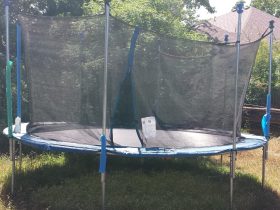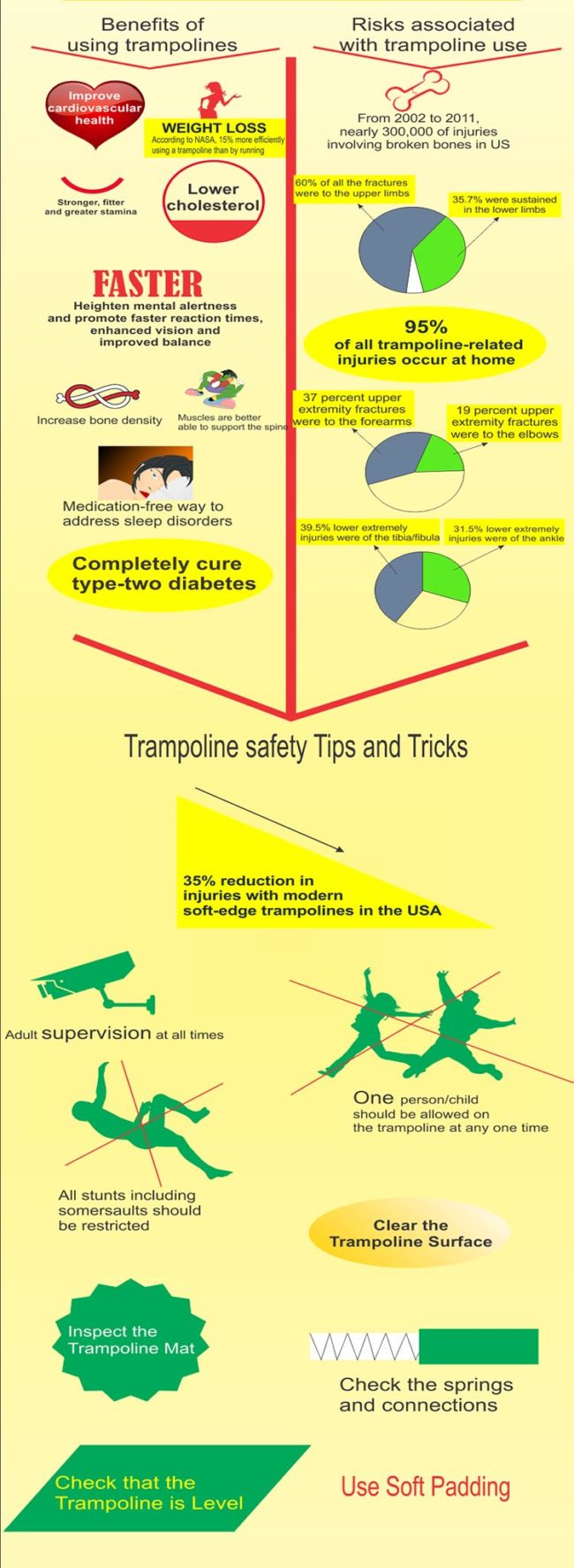Over the years, professional associations like the American Academy of Orthopaedic Surgeons and the American Academy of Pediatrics have issued various safety statements.
These organizations have conducted studies whose results indicate that trampolines are a significant health hazard and a financial burden to the state. They recommend that homeowners avoid purchasing and using trampolines in their homes because of the risk it poses to their children (the primary users).
What’s the Safety Record on Trampolines?
Trampolines have been labeled as a piece of equipment and not a toy. However, just like other sports, you have to consider the benefits and the risks. If you have a trampoline for your kids in the backyard, you should know how to keep them safe.
If you are thinking about getting a trampoline for your child, it is important to note that they can still enjoy it without suffering the various injuries outlined above.
The secret here is to take the time to ensure safety by adhering to some useful safety precautions. This will keep the fun going and avoid the painful hurt.
What’s more, being with trampolines also helps your child be safer if they go to a trampoline park or somewhere like that in the future.
Is trampoline safety and fitness for you?
If you are looking for a trampoline, you should understand what are the benefits and are risks associated. In this infographic, I will show the most important factors for consideration. As you may know, trampoline related accidents have decreased recently.
But safety is always important for bouncing sports like trampolining. We hope this infographic will help you in some ways.
Tips on Ensuring Trampoline Safety
As seen above, the injury threat posed by trampoline use is real. But as a parent, you can be able to minimize this risk by ensuring safe use. Let’s take a look at some useful tips to help you create a safer game environment. Create a safe play environment for your children at home.
Clear the Trampoline Surface
First and foremost, before anyone gets on the trampoline, make sure that the surface is clear of any twigs, sticks, toys and leaves. These small objects usually increase the risk of injury. Pricks, bruises and knocks will be more probable when numerous objects are positioned on the trampoline surface.
After clearing the trampoline, move on to the surrounding area as well. It is best to clear the entire circumference of the surrounding area so as to minimize the risk of serious injury aggravated by landing on hard objects. It is often recommended that a two feet perimeter surrounding the trampoline be littered with soft landing material.
Inspect the Trampoline Mat
Most people rarely inspect the trampoline mat for tears and rips that further increase the risk of hard landings and resultant injuries.
It is also important to note that covering any tears and rips with duct tape is discouraged as it does not change how the mat responds when under pressure.
Getting a professional to inspect the mat is a great way of ensuring that everything is as it should be.
Check the springs, and Connections
Once you are sure that the mat is intact, check the springs and make sure that each is connected to the mat and frame correctly.
This also includes checking to see whether the springs are structurally sound and not cracked or broken.
Where the springs are not intact, the trampoline will not hold up to jumps as it should. This increases the risk of hard landings as well.
Check that the Trampoline is Level
A trampoline should be installed on level ground, this should be checked regularly. Since trampolines should not be installed on concrete floors for obvious reasons.
It is also important to ensure that the legs do not sink into the ground and cause it to be unstable.
Jumping on a trampoline that is not level will most probably cause an awkward jump.
A higher chance of landing similarly awkward and hence increase the chances of sustaining injuries.
Safety Net
Even with a level trampoline and healthy mat, the risk of falling off the trampoline still exists and with it the associated risk of injury.
However, a trampoline safety net can be used to prevent these falls. By eliminating the risk of falling off the trampoline, you also eliminate the risk of injury.
Use Soft Padding
Some common trampoline injuries are caused by falling on the metal springs and frame.
Parents can buy padding and wrap it around these parts to make them softer and easier to land on if and when the kids do.
It is also advisable to get padding for the trampoline safety net support structure as well.
Lay Down Some Playing Rules
Even if you’ve identified all of the above, the main risk of using a trampoline is when kids get on the trampoline. Parents should lay down rules on use to further boost this safety.
To avoid collisions between kids, only one person/child should be allowed on the trampoline at any one time. All stunts including somersaults should also be restricted to avoid injuries due to flawed execution and technique.
Children under the age of six should not be allowed on the trampoline as recommended by the American Academy of Orthopedic Surgeons. Most importantly, if you have kids at age of two to six playing trampolines, supervision is a must.
According to experience, when using a trampoline, safety should always be the first consideration. As a parent, it’s your responsibility to make sure that your child’s trampoline is a source of happiness. But that every time they play on it, they are as safe as possible.
Otherwise, you not only have to endure frequent injuries, but also be prepared to face lawsuits from neighbors. Because their child got hurt playing trampoline in your yard.





















Leave a Reply
View Comments